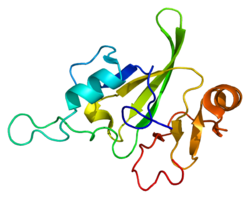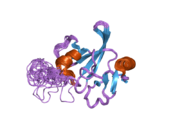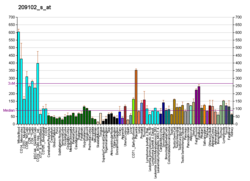HBP1
Protein-coding gene in the species Homo sapiens
| HBP1 | |||||||||||||||||||||||||||||||||||||||||||||||||||
|---|---|---|---|---|---|---|---|---|---|---|---|---|---|---|---|---|---|---|---|---|---|---|---|---|---|---|---|---|---|---|---|---|---|---|---|---|---|---|---|---|---|---|---|---|---|---|---|---|---|---|---|
 | |||||||||||||||||||||||||||||||||||||||||||||||||||
| |||||||||||||||||||||||||||||||||||||||||||||||||||
| Identifiers | |||||||||||||||||||||||||||||||||||||||||||||||||||
| Aliases | HBP1, HMG-box transcription factor 1 | ||||||||||||||||||||||||||||||||||||||||||||||||||
| External IDs | OMIM: 616714; MGI: 894659; HomoloGene: 8171; GeneCards: HBP1; OMA:HBP1 - orthologs | ||||||||||||||||||||||||||||||||||||||||||||||||||
| |||||||||||||||||||||||||||||||||||||||||||||||||||
| |||||||||||||||||||||||||||||||||||||||||||||||||||
| |||||||||||||||||||||||||||||||||||||||||||||||||||
| |||||||||||||||||||||||||||||||||||||||||||||||||||
| |||||||||||||||||||||||||||||||||||||||||||||||||||
| Wikidata | |||||||||||||||||||||||||||||||||||||||||||||||||||
| |||||||||||||||||||||||||||||||||||||||||||||||||||
HMG-box transcription factor 1, also known as HBP1, is a human protein.[5]
Interactions
HBP1 has been shown to interact with SIN3A[6] and Retinoblastoma protein.[7]
References
- ^ a b c ENSG00000283847 GRCh38: Ensembl release 89: ENSG00000105856, ENSG00000283847 – Ensembl, May 2017
- ^ a b c GRCm38: Ensembl release 89: ENSMUSG00000002996 – Ensembl, May 2017
- ^ "Human PubMed Reference:". National Center for Biotechnology Information, U.S. National Library of Medicine.
- ^ "Mouse PubMed Reference:". National Center for Biotechnology Information, U.S. National Library of Medicine.
- ^ "Entrez Gene: HBP1 HMG-box transcription factor 1".
- ^ Swanson KA, Knoepfler Paul S, Huang Kai, Kang Richard S, Cowley Shaun M, Laherty Carol D, Eisenman Robert N, Radhakrishnan Ishwar (Aug 2004). "HBP1 and Mad1 repressors bind the Sin3 corepressor PAH2 domain with opposite helical orientations". Nat. Struct. Mol. Biol. 11 (8): 738–46. doi:10.1038/nsmb798. ISSN 1545-9993. PMID 15235594. S2CID 44324333.
- ^ Lavender P, Vandel L, Bannister A J, Kouzarides T (Jun 1997). "The HMG-box transcription factor HBP1 is targeted by the pocket proteins and E1A". Oncogene. 14 (22): 2721–8. doi:10.1038/sj.onc.1201243. ISSN 0950-9232. PMID 9178770.
Further reading
- Tevosian SG, Shih HH, Mendelson KG, et al. (1997). "HBP1: a HMG box transcriptional repressor that is targeted by the retinoblastoma family". Genes Dev. 11 (3): 383–96. doi:10.1101/gad.11.3.383. PMID 9030690.
- Lavender P, Vandel L, Bannister AJ, Kouzarides T (1997). "The HMG-box transcription factor HBP1 is targeted by the pocket proteins and E1A". Oncogene. 14 (22): 2721–8. doi:10.1038/sj.onc.1201243. PMID 9178770.
- Zhuma T, Tyrrell R, Sekkali B, et al. (2000). "Human HMG box transcription factor HBP1: a role in hCD2 LCR function". EMBO J. 18 (22): 6396–406. doi:10.1093/emboj/18.22.6396. PMC 1171702. PMID 10562551.
- Lemercier C, Duncliffe K, Boibessot I, et al. (2000). "Involvement of Retinoblastoma Protein and HBP1 in Histone H10 Gene Expression". Mol. Cell. Biol. 20 (18): 6627–37. doi:10.1128/MCB.20.18.6627-6637.2000. PMC 86159. PMID 10958660.
- Shih HH, Xiu M, Berasi SP, et al. (2001). "HMG Box Transcriptional Repressor HBP1 Maintains a Proliferation Barrier in Differentiated Liver Tissue". Mol. Cell. Biol. 21 (17): 5723–32. doi:10.1128/MCB.21.17.5723-5732.2001. PMC 87292. PMID 11486012.
- Sampson EM, Haque ZK, Ku MC, et al. (2001). "Negative regulation of the Wnt–β-catenin pathway by the transcriptional repressor HBP1". EMBO J. 20 (16): 4500–11. doi:10.1093/emboj/20.16.4500. PMC 125566. PMID 11500377.
- Strausberg RL, Feingold EA, Grouse LH, et al. (2003). "Generation and initial analysis of more than 15,000 full-length human and mouse cDNA sequences". Proc. Natl. Acad. Sci. U.S.A. 99 (26): 16899–903. Bibcode:2002PNAS...9916899M. doi:10.1073/pnas.242603899. PMC 139241. PMID 12477932.
- Hillier LW, Fulton RS, Fulton LA, et al. (2003). "The DNA sequence of human chromosome 7". Nature. 424 (6945): 157–64. Bibcode:2003Natur.424..157H. doi:10.1038/nature01782. PMID 12853948.
- Ota T, Suzuki Y, Nishikawa T, et al. (2004). "Complete sequencing and characterization of 21,243 full-length human cDNAs". Nat. Genet. 36 (1): 40–5. doi:10.1038/ng1285. PMID 14702039.
- de Chiara C, Kelly G, Frenkiel TA, Pastore A (2004). "Assignment of the 1H, 13C, and 15N resonances of the AXH domain of the transcription factor HBP1". J. Biomol. NMR. 28 (4): 411–2. doi:10.1023/B:JNMR.0000015367.92295.0f. PMID 14872137. S2CID 43367627.
- Berasi SP, Xiu M, Yee AS, Paulson KE (2004). "HBP1 Repression of the p47phox Gene: Cell Cycle Regulation via the NADPH Oxidase". Mol. Cell. Biol. 24 (7): 3011–24. doi:10.1128/MCB.24.7.3011-3024.2004. PMC 371097. PMID 15024088.
- Colland F, Jacq X, Trouplin V, et al. (2004). "Functional Proteomics Mapping of a Human Signaling Pathway". Genome Res. 14 (7): 1324–32. doi:10.1101/gr.2334104. PMC 442148. PMID 15231748.
- Swanson KA, Knoepfler PS, Huang K, et al. (2004). "HBP1 and Mad1 repressors bind the Sin3 corepressor PAH2 domain with opposite helical orientations". Nat. Struct. Mol. Biol. 11 (8): 738–46. doi:10.1038/nsmb798. PMID 15235594. S2CID 44324333.
- Gerhard DS, Wagner L, Feingold EA, et al. (2004). "The Status, Quality, and Expansion of the NIH Full-Length cDNA Project: The Mammalian Gene Collection (MGC)". Genome Res. 14 (10B): 2121–7. doi:10.1101/gr.2596504. PMC 528928. PMID 15489334.
- Yao CJ, Works K, Romagnoli PA, Austin GE (2005). "Effects of overexpression of HBP1 upon growth and differentiation of leukemic myeloid cells". Leukemia. 19 (11): 1958–68. doi:10.1038/sj.leu.2403918. PMID 16179914. S2CID 10030062.
- Rual JF, Venkatesan K, Hao T, et al. (2005). "Towards a proteome-scale map of the human protein–protein interaction network". Nature. 437 (7062): 1173–8. Bibcode:2005Natur.437.1173R. doi:10.1038/nature04209. PMID 16189514. S2CID 4427026.
- Sekkali B, Szabat E, Ktistaki E, et al. (2005). "Human high mobility group box transcription factor 1 affects thymocyte development and transgene variegation". J. Immunol. 175 (8): 5203–12. doi:10.4049/jimmunol.175.8.5203. PMID 16210625.
- Kim J, Zhang X, Rieger-Christ KM, et al. (2006). "Suppression of Wnt signaling by the green tea compound (-)-epigallocatechin 3-gallate (EGCG) in invasive breast cancer cells. Requirement of the transcriptional repressor HBP1". J. Biol. Chem. 281 (16): 10865–75. doi:10.1074/jbc.M513378200. PMID 16495219.
- Lim J, Hao T, Shaw C, et al. (2006). "A protein–protein interaction network for human inherited ataxias and disorders of Purkinje cell degeneration". Cell. 125 (4): 801–14. doi:10.1016/j.cell.2006.03.032. PMID 16713569. S2CID 13709685.
- Zhang X, Kim J, Ruthazer R, et al. (2007). "The HBP1 Transcriptional Repressor Participates in RAS-Induced Premature Senescence". Mol. Cell. Biol. 26 (22): 8252–66. doi:10.1128/MCB.00604-06. PMC 1636767. PMID 16966377.
- v
- t
- e
PDB gallery
-
 1v06: AXH DOMAIN OF THE TRANSCRIPTION FACTOR HBP1 FROM M.MUSCULUS
1v06: AXH DOMAIN OF THE TRANSCRIPTION FACTOR HBP1 FROM M.MUSCULUS
External links
- HBP1+protein,+human at the U.S. National Library of Medicine Medical Subject Headings (MeSH)
 | This article on a gene on human chromosome 7 is a stub. You can help Wikipedia by expanding it. |
- v
- t
- e



















